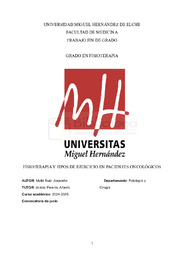Por favor, use este identificador para citar o enlazar este ítem:
https://hdl.handle.net/11000/37538Registro completo de metadatos
| Campo DC | Valor | Lengua/Idioma |
|---|---|---|
| dc.contributor.advisor | Jarabo Pereda, Alberto | - |
| dc.contributor.author | Mollá Ruiz, Alejandro | - |
| dc.contributor.other | Departamentos de la UMH::Patología y Cirugía | es_ES |
| dc.date.accessioned | 2025-09-24T11:47:11Z | - |
| dc.date.available | 2025-09-24T11:47:11Z | - |
| dc.date.created | 2025-05-15 | - |
| dc.identifier.uri | https://hdl.handle.net/11000/37538 | - |
| dc.description.abstract | El tratamiento del cáncer conlleva una gran complejidad, debido a la gran cantidad de procesos diferentes y etapas que pasan los distintos pacientes. Además, estos procesos llevan a los pacientes a una sensación de malestar general, gran desacondicionamiento físico y gran carga psicológica. Estos factores pueden ser tratados de distintas formas por los profesionales sanitarios. En nuestro caso, observamos mediante una revisión de bibliografía los efectos que producen los tipos de ejercicio terapéutico, como puede ser el ejercicio aeróbico y de fuerza. Y cual es el papel del fisioterapeuta y sus terapias en el campo de la oncología. Para la búsqueda de información, utilicé diferentes bases de datos como Pubmed, Cochrane, Scopus, PEDro… e hicimos una selección de los estudios que consideramos más relevantes y que mejor encajaban con nuestros criterios. Dentro de estos, se encontraban el no ser más antiguos de 2009, que incluyeran pacientes de cualquier edad con procesos oncológico, con una intervención fisioterápica… En los resultados, la literatura encontrada muestra que el ejercicio y la fisioterapia son terapias seguras y efectivas para mejorar condiciones como la calidad de vida, la fatiga y la función física, entre otras, en los pacientes oncológicos. Por tanto, la realización de ejercicio físico, de cualquier tipo, mediante la intervención de un fisioterapeuta es importante para mejorar la calidad de vida y tener mejor recuperación dentro de los procesos mejorables del cáncer. Además, ayuda a prevenir complicaciones y ciertos tipos de cáncer por lo que debería de ser tenido en cuenta como intervención. Cancer treatment involves great complexity, due to the large number of different processes and stages that different patients go through. In addition, these processes lead patients to a feeling of general malaise, great physical deconditioning and great psychological burden. These factors can be treated in different ways by health professionals. | es_ES |
| dc.description.abstract | In our case, we observed through a literature review the effects produced by types of therapeutic exercise, such as aerobic and strength exercise. And what is the role of the physiotherapist and their therapies in the field of oncology. For the search for information, I used different databases such as Pubmed, Cochrane, Scopus, PEDro... and we made a selection of the studies that we considered most relevant and that best fit our criteria. Among these, were the fact that they were no older than 2010, which included patients of any age with oncological processes, with a physiotherapy intervention... In the results, the literature found shows that exercise and physiotherapy are safe and effective therapies to improve conditions such as quality of life, fatigue and physical function, among others, in cancer patients. Therefore, physical exercise, of any kind, through the intervention of a physiotherapist is important to improve quality of life and have better recovery within the processes that can be improved by cancer. In addition, it helps prevent complications and certain types of cancer, so it should be taken into account as an intervention. | es_ES |
| dc.format | application/pdf | es_ES |
| dc.format.extent | 24 | es_ES |
| dc.language.iso | spa | es_ES |
| dc.publisher | Unviersidad Miguel Hernández | es_ES |
| dc.rights | info:eu-repo/semantics/openAccess | es_ES |
| dc.rights | Attribution-NonCommercial-NoDerivatives 4.0 Internacional | * |
| dc.rights.uri | http://creativecommons.org/licenses/by-nc-nd/4.0/ | * |
| dc.subject | paciente oncológico | es_ES |
| dc.subject | fisioterapia | es_ES |
| dc.subject | ejercicio terapéutico | es_ES |
| dc.subject | ejercicio aeróbico | es_ES |
| dc.subject | ejercicio de fuerza | es_ES |
| dc.subject.other | CDU::6 - Ciencias aplicadas | es_ES |
| dc.title | Fisioterapia y tipos de ejercicio en pacientes oncológicos. | es_ES |
| dc.type | info:eu-repo/semantics/bachelorThesis | es_ES |

Ver/Abrir:
TFG_Molla_Ruiz,Alejandro.pdf
1,24 MB
Adobe PDF
Compartir:
 La licencia se describe como: Atribución-NonComercial-NoDerivada 4.0 Internacional.
La licencia se describe como: Atribución-NonComercial-NoDerivada 4.0 Internacional.
.png)